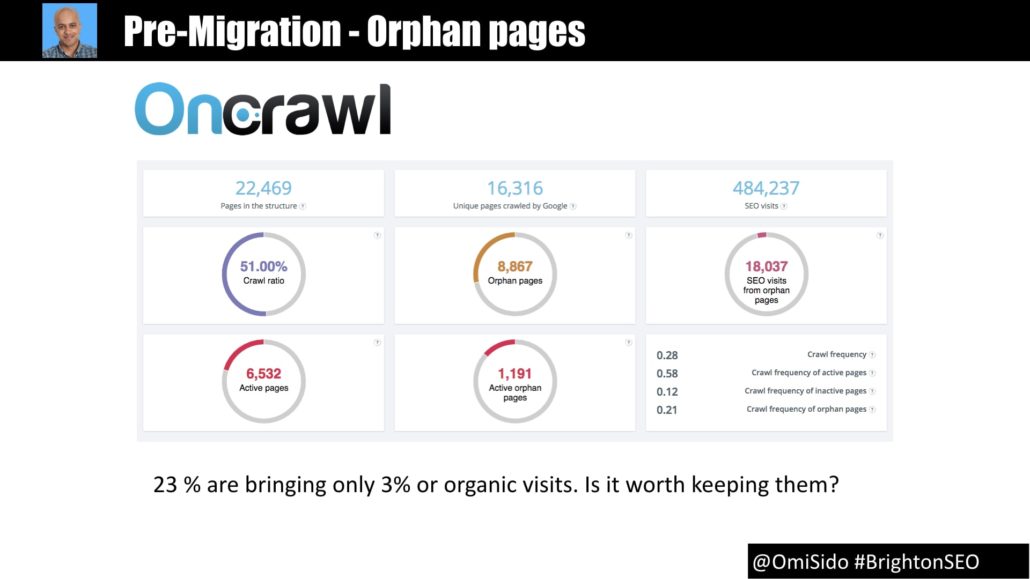Hi, guys. Thank for coming here today. Kelvin thank you for inviting me to this wonderful conference.
My name is Omi Sido and as most of you know I love talking about SEO and the way SEO can help you achieve your business goals.
Today I’m gonna to be talking about website migration but as you can see from the title I’m not gonna talk about SEO checklists. You can google them. You can find online and you can follow them.
When SEOs and indeed a lot of SEO speakers talk about website migration normally they talk about disasters. Big fat juicy disasters.
But this is not the way I think about SEO. In my opinion and experience, SEO is one of those rare moments in your SEO career when you can massively and I will repeat massively increase the SEO value of your website in one go. What do I mean by that? Stay with me and I’ll take you on a short journey.
First, website migration is one of those rare moments where you can educate your whole SEO team on all aspects of SEO.
A lot of SEOs are talking only about content and also I see a lot of SEO teams out there built with only content SEOs. To be honest with you yes ‘Content is King’ but if you follow me online you know what I normally say to this statement. Content is King but every King needs a castle home to live with his queen or a lover. You know the story.
Website migration is also one of those rare moments where you can explain what SEO is to every single department of your company especially development and content so they can help you achieve your SEO goals in the future.
Saying that for successful website migration you need a cross-functional migration team. A lot of speakers – SEO speakers say the SEO guy should be in charge. But why would the SEO guy waste his time and effort with the development process or the content process? The SEO guy should concentrate on the SEO tasks.
So you are an SEO – you are in charge. Your SEO plan should have minimum minimum 4 SEO sections. The SEO migration plan the thing that you all love the checklist. The content migration plan that you gonna build with your content team. The development migration plan that you gonna build with your development team and timelines.
Timelines are crucial especially for e-commerce websites as you have to make sure that your website is working properly at peak times when your business is making money. And then paying your salary.
But going back SEO guy and the SEO plan. Many SEOs many speakers talk about the SEO migration as a two-stage process. Your SEO plan should have minimum three stages. Let me just go back to the two-stage process. The two-stage process normally is the SEO checklist press the button disaster. Minimum three stages and in my opinion and my experience the more time you spend on the pre-migration stage the better your chances are of a successful website migration. Also in my experience ninety-nine percent of the time the SEO checks that you do in pre-migration stage, you should be doing anyway on a monthly basis. Welcome to the pre pre-migration stage of the website migration. If you don’t have a name for this stage just call it the Omi Stage. Yeah, I am honest.
So I can’t see the numbers there. Anyway.
So this is a website that was migrated a few months ago. Literally, five six months ago and those are real numbers.
Twenty thousand primary pages. Fourteen thousand pages with duplicate descriptions. Three thousand pages 301. Three thousand pages non-200. Do you really want to migrate those issues to the new platform? In my experience, those issues on the new platform will double triple quadruple. On the other side, your beautifully crafted content counts for nothing if the bot comes and goes into a loop or it’s redirected to the pages that don’t matter for your business. Ups, sorry.
Something I want to say as it just came to mind now. Let’s forget about the website migration for a second. As digital marketers I want you to go back to your jobs on Monday and ask the SEO guy. When was the last time you performed a full crawl of our website? Give me the number of 404s the reason and what we are doing about it. Give me the number 301s the reason and what we are doing about it.

Saying that there is one subject that not many SEOs are talking about – orphan pages. What are orphan pages? Orphan pages are pages on our website that are linked from nowhere. How do we find orphan pages? We perform a full crawl of our website. Then we take all the server logs. We combine the data and we analyze it. How many of you are doing on a monthly basis analysis of server logs? Raise your hands. Oh, yeah. It’s about time. Honestly, I only saw three hands. It’s about time you stop blaming Google that Google doesn’t understand your website structure or it’s not indexing your pages properly if you don’t analyse the server logs of your website.
But going back to the website migration. Eight thousand pages – orphan pages. This is twenty-three percent – those are real numbers and this is the same website from the previous slide – 23% are bringing only three percent of organic visits. Do you really want to migrate those pages to the new platform? Of course, a lot of you don’t know about them because your crawls are not finding those pages because they’re not linked in your system.
On the other side image that this was not three percent. This was – I’ve seen this case as well where the orphan pages are bringing say 30% of organic visits. Why are you not linking to those orphan pages?
Talking about similar to orphan pages 404 pages. My advice. If there are no links pointing at them please discard them. Now before the website migration takes place. Not on staging. Now.
On the other side, if a lot of good links are pointing at them now is the time to work with your content team to either reinstate them, improve the content. You should do something about it. Now. Not on staging and not after the migration has taken place.
So now we know everything about our website. We know from a technical point of view it’s time to benchmark check and benchmark our rankings. This is the only way by benchmarking our rankings this is the only way to know how successful our migration was.
But you have to do it now. Not on staging. And not after the migration has taken place.
Talking about rankings – sorry for going back and forwards – ninety percent of the cases parallel to your typical technical migration there is a content migration going on. Now is the time to work with your content team and either combine those pages/content create new sections.
You are doing this now. Before you go on staging.
Now that we are on staging with or without a website migration it amazes me that in the year 2017 I can still see staging environments crawled and ranked by Google. Because you cannot be asked to do the simplest of technical SEO tasks. You are diluting your rankings and the only reason to do that or shall I say due to your laziness.
We are still on staging 301 mapping we all know this is one of the most important parts of the website migration. But I’m not gonna talk about that.
I’m gonna talk about the fact that during your 301 mapping this is the best chance for you to clean your product offerings. Expired pages, pages that don’t have equivalents on the new platform. Many developers not instructed properly by their SEO, the SEOs that are in charge will redirect pages to irrelevant sections on your website or God forbid the home page. The thing that I am saying now is with or without a website migration. Many SEOs are arguing online what’s happening here and saying this is the best way to preserve your SEO juice. Hard earned SEO juice. You can’t be more wrong. After some time Google will start treating those 301 redirects to relevant sections on your website as soft 404s and after some time it will deindex them. So you gonna lose all the hard-earned SEO juice.
And to give you a good example. Last year royal.gov.uk was migrated to royal.uk.
Before we continue ‘The home of the Royal Family.’ What did I tell you ten minutes ago? Every King needs a castle, a home to live with his King…queen.

So the people. It’s a funny story as well I know I was laughing when I found this website. So the people who were migrating the home/technical SEO of the Royal Family last year couldn’t be bothered to redirect the expired pages, pages with no equivalents to the equivalent parts of the website so they ended up with roughly 80% of pages redirected to the home page. The result.
Within one week those clever developers/SEOs destroyed completely the castle the home/technical SEO of the Royal Family. This website lost around 80% of its rankings in one single week. Go and check it out. Everything is still in place so you can actually learn from mistakes.
I can see Purna finding it very funny. It’s not actually funny. Yeah, it’s tragic.
We are still talking about 301 mapping and this is the time for you to clean your chain redirects. If you’ve been following me online you know I hate chain redirects. And it’s very simple. If page A on the old system was 301 redirecting to page B now page A will 301 redirect to page C – this is the new platform and this page is equivalent to page B and page B will 301 redirect to page C. Simple and effective.
Now is the time to make sure on staging that the tracking code is implemented is present literary on every single section on your website.
Now that you managed to educate your whole SEO team. You’ve managed to educate your whole company of what SEO is. You are doing your full website crawls every month and you are analyzing the data you are ready to press the button.
Guys, I did include some post-migration checks because they are very very important. But for now, thank you very much and hope to see you soon.


Leave a Reply